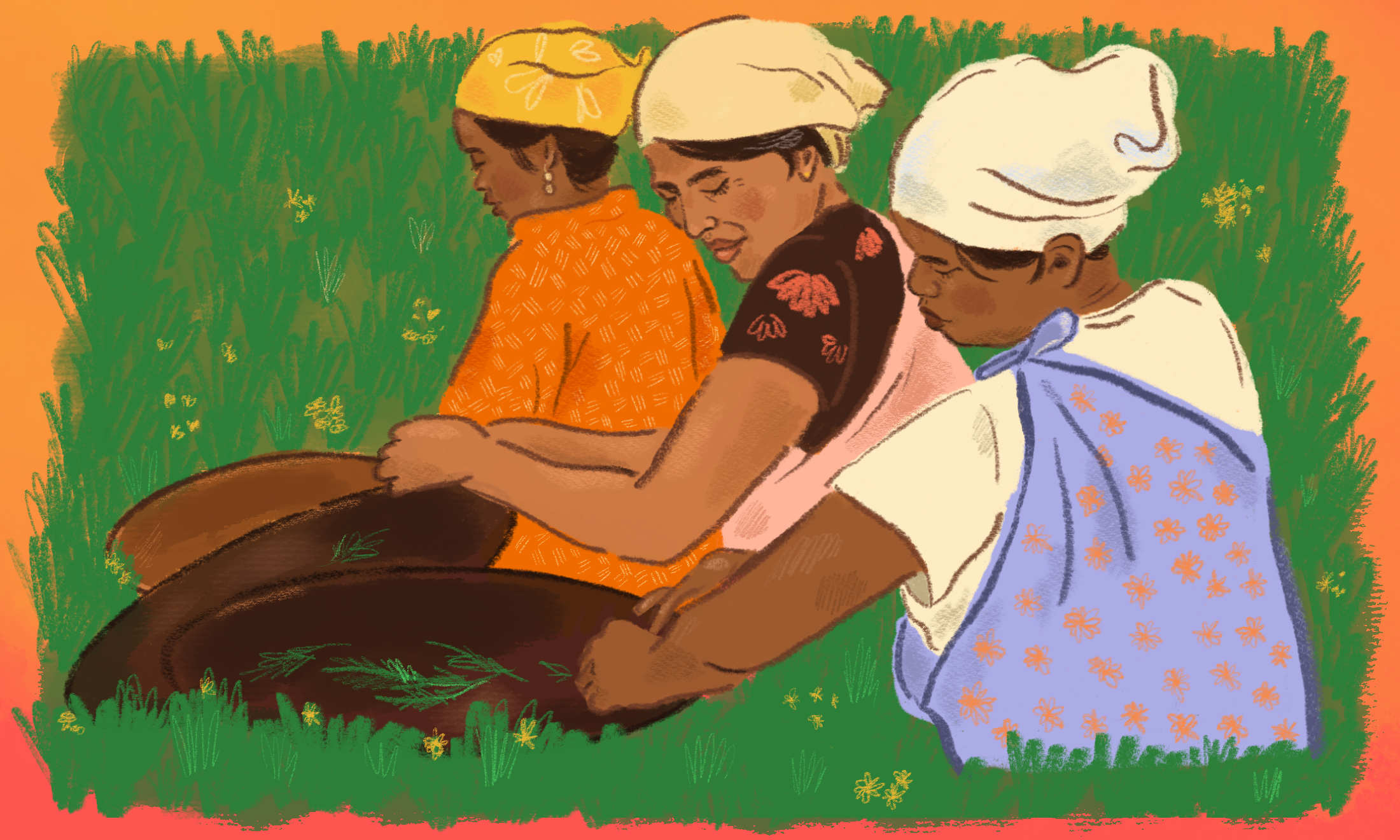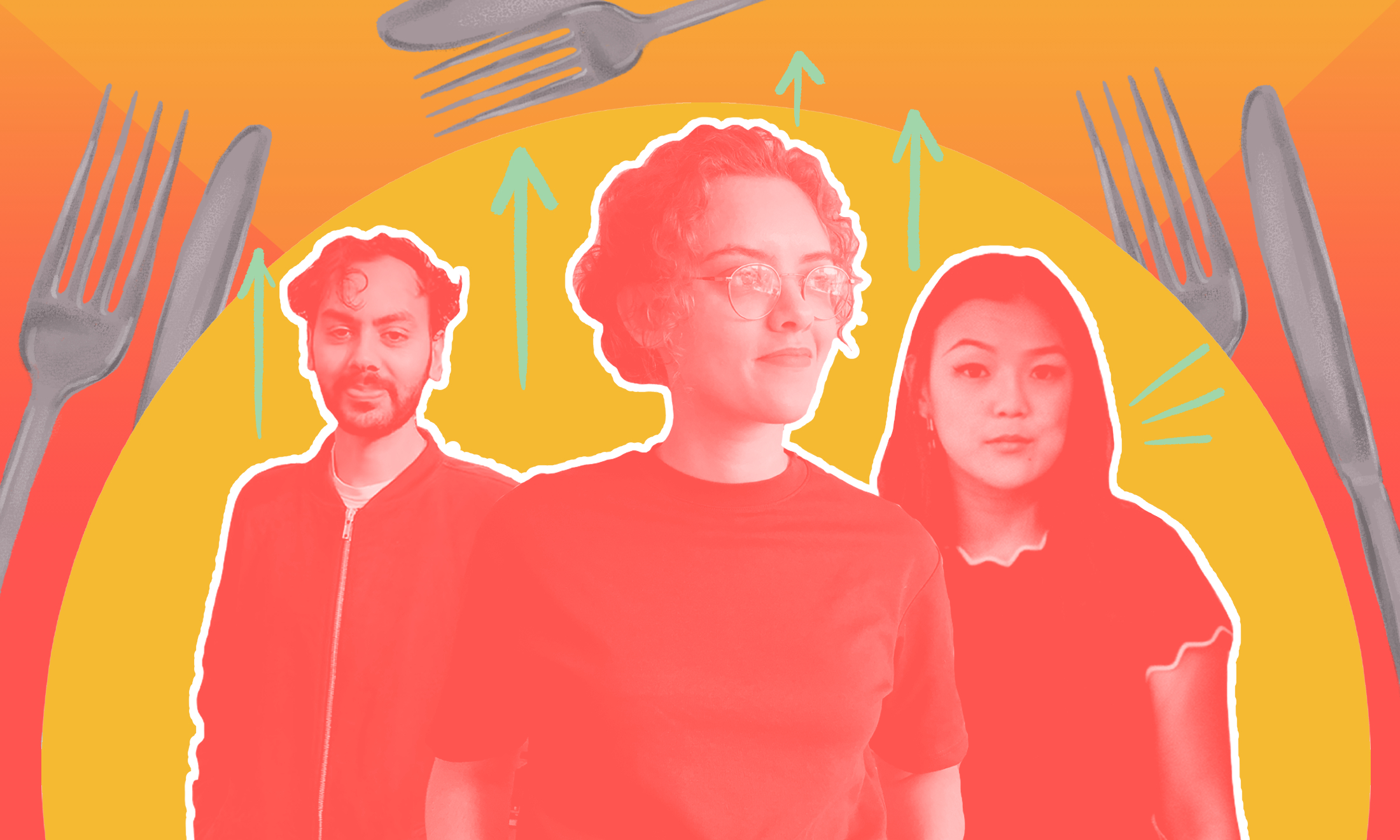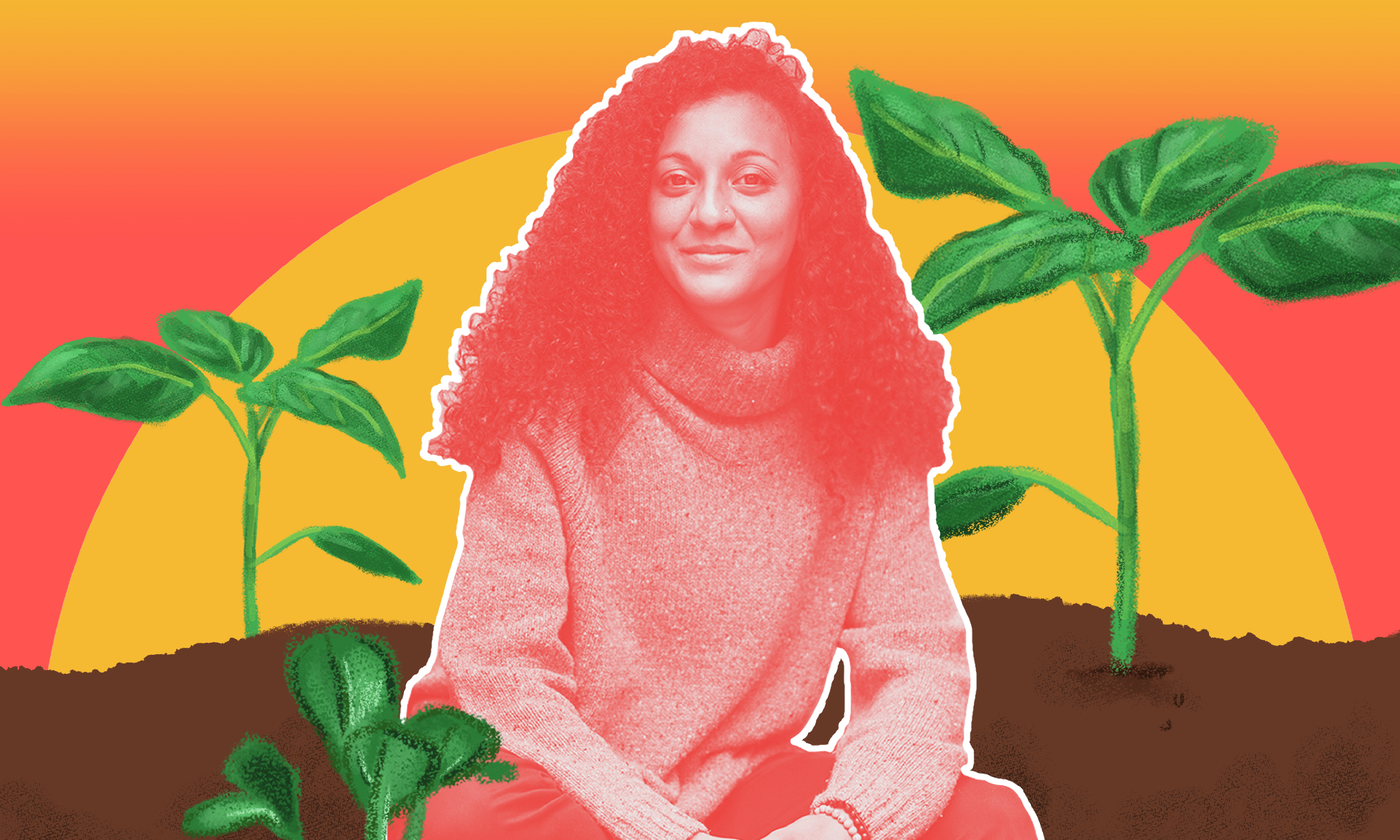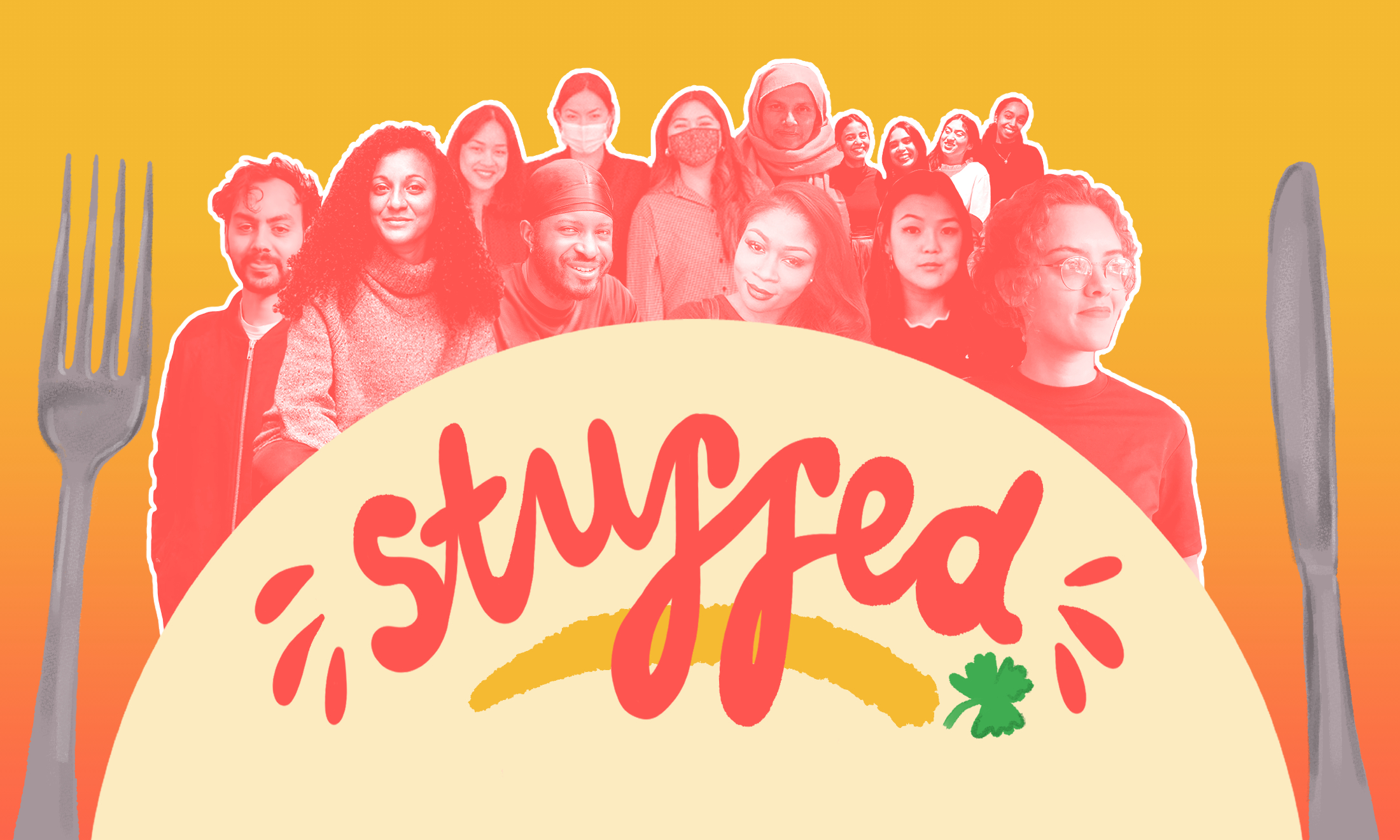
Illustration by Javie Huxley
Stuffed: the fight to decolonise Indigenous foods
These activists and researchers are forging a new relationship with Indigenous diets in South Africa, Indonesia and in the Japanese archipelago.
Samyama Kolhapuri
23 Jul 2022
Many Indigenous communities across the globe have long histories of finding ways to live alongside nature; not seeing land as something to own, but believing in belonging to it.
Yet, in the wake of impactful unilateral decisions made by ruling governments and the legacy of colonialism, Indigenous people throughout the world have been displaced, forced to assimilate and in some cases, restricted from living their traditional ways of life – exemplified through a loss of traditional knowledge, health issues and the degradation of once protected ecosystems.
In the 1980s, the Indonesian forests were cleared for farming and local communities were resettled, leaving them dependent on the government for rice. In 1948 in South Africa, Apartheid was enforced and Black South Africans lacked access to traditional foods relying instead on state-supported maize. And for the Ainu people, an Indigenous group hailing from the northern region of the Japanese archipelago, who historically relied on hunting, were forced to turn to agriculture in 1847 after deer hunting was banned by the Meiji government (Japanese settlers).
Now there is a new generation of Indigenous activists who want to return to their ancestral understanding of food while educating future generations and reintroducing these foods to a new audience.
Diversifying food sources with research in Indonesia
Hayu Dyah Patria is a biodiversity leader and the founder of Mantasa, a multidisciplinary research organisation that studies the use of wild plants in local Indonesian cultures.
It’s her goal to understand why a biodiverse country like Indonesia struggles with the burden of malnutrition. She travels to remote places in Indonesia – east Java, west Java, west Papua, east Nusa Tenggara, Borneo and Flores – to explore mushrooms, green vegetables, tubers and other plants that grow in their forests and along the coasts.
Although the crops were grown without pesticides, herbicides or chemical fertilizers, Hayu says they are viewed as “food for the poor”. She traces this mindset to the enactment of the New Order regime by President Suharto. The New Order focused on the unity, uniformity and conformity of all Indonesians, which resulted in the suppression of the cultural identities of many diverse communities.
Dedicated to economic development, from 1969 to 1999, they resettled 4.5 million people in the outer islands with the help of the World Bank and other international donors. Some migrants found suitable land for agriculture. Others, however, weren’t as lucky. Nonetheless, Indigenous people were some of the worst affected as their ancestral lands were taken and cleared for redistribution.
BULOG, a food logistics agency, was then established to control rice prices. “The government wanted Indonesians to eat rice everywhere and push towards self-sufficiency with their rice. They proclaimed that you are not fully Indonesian until you eat rice,” says Hayu
“In this village, fennel grows wildly and abundantly, but it’s often considered useless”
Hayu Dyah Patria
Fear of the regime and rice being heavily subsidised led many Indigenous people to let go of their other staples like plantains, yams, sago and tubers. Consequently, biodiversity decreased and traditional food knowledge was lost, including the ability to recognise wild plants and seed breeding skills among farmers.
Hayu recalls the Indigenous Food Festival held in Tengger, East Java, in 2020. In collaboration with a chef, she created new recipes to reacquaint the Tenggerese with their traditional ingredients. With ganyong (Canna discolor), once a staple tuber, they made roasted ganyong rice with ranti leaves served with wild mushrooms wrapped in banana leaves; roasted chicken and roasted ganyong with fennel sauce; and ganyong meatballs which were otherwise made of wheat flour.
“The Tenggerese people live in a village called Ngadas which originated from the word ‘adas’ (fennel),” explains Hayu. “In this village, fennel grows wildly and abundantly, but it’s often considered useless. We took a modern approach and made spaghetti with fennel pesto. It was a great hit even with the kids. Now, instead of serving processed foods (instant noodles, sausage or fried rice) to tourists, they try to showcase their culture with new recipes.”
Still, marketing the vegetables to organic markets in Surabaya, the second biggest city in Indonesia, was not easy. “People were more receptive when ingredients were cooked into different kinds of foods,” says Hayu. “Still, there is hope as people have fond memories of these recipes from childhood that bring them comfort.”
Reevaluating health education in South Africa
Mpho Tshukudu is an integrative and functional nutrition dietitian and author who says that clients come to her to treat lifestyle diseases, like high blood pressure, cholesterol, heart disease and diabetes. Most of them are over 40 and upset about their diagnosis. She says many people are unaware of why they have these diagnoses when it is not genetic. Their backstories later reveal a common journey; many of them grew up in rural areas before moving to the city for work, causing a drastic diet change.
“They don’t realise that the food in the cities are not the same as where they came from. When they come from a dusty rural area with no electricity to the shiny city of Johannesburg, they begin to think that if they can’t see [where their food comes from], it isn’t good enough. This leads them to eat processed foods full of sugars and fats.”
Elders from her family, the community and even her patients often share recipes and memories of sorghum, millet, amaranth, cassava and wild leaves with her. These foods reflect their pre-colonial culture, before the forceful upheaval of their rights and ways of life.
An impactful example of food colonisation leading to declining health can be seen in the boom of maize. Maize made early appearances in Southern African farms to fit into specific seasonal cycles or to help manage soil fertility for other staple crops. It was popular for its high yields, low labour requirements and short seasonal growth.
The apartheid policy, a system of institutionalised racial segregation, was enforced in 1948, ensuring that the minority white population dominated both socially and politically. This bolstered the prohibition of Black people from owning or leasing land, which displaced millions of Black sharecroppers and strengthened white farmers’ investments in commercial agriculture through maize production.
Homemade meals for the Sotho people (Basutos), natives of southern Africa, typically included bread and porridge made from sorghum or wheat, plus a corn-based dish and other side dishes made of greens, beans or vegetables. But after apartheid, the government focused on cheap food solutions. Men ate commercial mealie ‘papa’ (corn mush) and women and children ate their household crops.
“The more we moved away from our Indigenous and cultural diets, the more our bodies failed us”
Mpho Tshukudu
Nutritionally, maize is a vegetable, rather than a grain. While it contains vitamins A, C and E, it lacks the vitamin B that makes grains like sorghum or wheat true grains. It is also high in carbohydrates and low in usable proteins. Consequently, the overdependence on maize created serious health issues like kwashiorkor, malnutrition caused by protein deficiency, and Pellagra, a skin disease caused by severe vitamin B3 (Niacin) deficiencies.
Today, African maize meal producers are bound by law to fortify their maize, but maize is still highly processed and has been genetically modified over the years.
Despite Black Africans comprising 80% of the South African population, Mpho suggests that nutrition education still focuses on Western foods because there has never been a concerted effort to change education’s focus since apartheid.
Mpho grew up in a modern home, exposed to both worlds. “It didn’t dawn on me until I worked in the villages,” she says. “They weren’t compliant when I suggested they eat foods I was taught about – salmon, brown rice, broccoli and asparagus.” Even though some people were willing to follow the meal plan to begin with, they weren’t able to follow through because they struggled to relate to it.
“We never paid attention to categorising, qualifying or even knowing the English name for our ingredients,” she says. “I realised that we took our native African grains for granted. The more we moved away from our Indigenous and cultural diets, the more our bodies failed us.”
Finding unity and belonging with food in Japan
“My grandfather was a community leader, he could not receive a higher education,” says Dr Kanako Uzawa who is an Ainu scholar, cultural advocate and artist. “He taught himself how to write and read. He believes education helps us stand on equal ground with the Japanese, especially if you’re an Ainu woman.” That was why Dr Kanako’s mum moved to Tokyo from the Ainu Nibutani community in Hokkaido (known as the birthplace of their culture) and why Dr Kanako lived a dual-cultured life.
In 1899 the Japanese parliament enacted the Hokkaido Former Aborigines Protection Act prohibiting the Ainu from trading in their traditional livelihood: hunting, fishing, and foraging herbs, berries, nuts, wild edible leaves, stalks, roots and seaweed. In its place, they were forced to adopt rice, beans, potatoes and livestock farming. The Act also allowed the Japanese government to redistribute Ainu land and required the Ainu to learn Japanese while banning their own language.
With decades of grassroots protests and resilience, the act was abolished in 1997. Later in 2008, with the nudge of the United Nations adopting the Declaration on the Rights of Indigenous Peoples, Japan officially recognised the Ainu as Indigenous people of Japan. Despite this, the Ainu are not treated equally. Just last year, the Japanese news programme Nippon had to apologise after a comedian made a joke calling Ainu people “dogs”.
In her youth, Dr Kanako didn’t notice the difference between her two worlds until she was 15, when her uncle was among the plaintiffs in a case against dam construction on community land without permission. “During this period, I found out that to be Ainu, is actually to be discriminated against.”
“Ainu culture is not limited to geographical location. Our memories and experiences are carried with us wherever we go”
Dr Kanako
In addition to their social challenges, Ainu people are still struggling to rebuild their livelihoods. The Honorary Chairman of Raporo Ainu Nation, Masaki Sashima, has been a spokesperson for Ainu fishing rights. In December 2020, he said the Urahorotokachi River, in which his ancestors fished, has narrowed from 200m to just 50m since being split off from the upper reaches of the Tokachi River, and so salmon rarely migrate upstream.
“The salmon are a precious inheritance from our ancestors. Someday, I hope to make the Urahorotokachi River into a place where more salmon will return. We want to catch salmon, not only as a lifestyle but as an economic activity. In so doing, we wish for the Ainu to be able to live independently,” Masaki Sashima said in 2020.
While in university, Dr Kanako worked at an Ainu restaurant called Rera Chise or ‘wind house’, which quickly became her safe space. Despite having only six tables, the small restaurant had a greater impact than a traditional museum in teaching people about Ainu culture, since food is interactive. “People were really curious. Food is something you take into your body which helps open [a] new dialogue. Where does it come from? Who made it? Why is it important? These questions are important to decolonising Indigenous food.”
It’s not only about the food for Dr Kanako. It’s also about the ambience, the posters of upcoming events and conversations had over food. People who kept returning make spaces like Rera Chise into a meeting place – a community.
“Ainu culture is not limited to geographical location. Our memories and experiences are carried with us wherever we go,” Dr Kanako says. Now living in Norway with her family, Dr Kanako enjoys preparing a simple salmon soup as a way to share their Ainu culture.
The future of decolonising food
There is no single pathway to decolonising food systems anywhere. But Hayu, Dr Kanako and Mpho all believe in a few important steps. Indigenous people must be assured of their rights to access natural resources and to self-determination. This will empower Indigenous communities, foster pride and guide their youth back to their roots.
Yet, it’s not all about history. It’s also about progress. In order to reap the most benefits from traditional ingredients, Indigenous people should be able to use modern technology and research techniques to study them without fear of exploitation.
There’s a long road ahead, but with inspiring figures taking action, change may be just around the corner.
Our groundbreaking journalism relies on the crucial support of a community of gal-dem members. We would not be able to continue to hold truth to power in this industry without them, and you can support us from £5 per month – less than a weekly coffee.
Our members get exclusive access to events, discounts from independent brands, newsletters from our editors, quarterly gifts, print magazines, and so much more!





